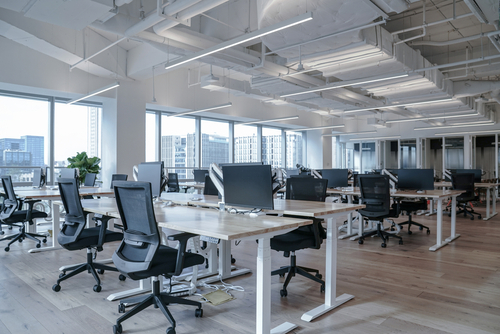North American tech companies, once the vanguard of workplace innovation, are still catching up to new work patterns. With average peak utilization not exceeding 34% in tech offices, up to $40 million in rent costs are wasted annually on underused space.

That’s according to a new report from international design practice Hassell and workplace analytics company Density. The State of Tech Industry Workplaces research report examined a full year’s usage of tech workspaces to understand the relationships between utilization, return-to-office (RTO) policies, and layout in more than 1.4 million square feet. Among its key findings are:
1. The impact of RTO policy on office utilization isn’t as significant as you’d expect. Going from a policy that lets employees decide when to come in, to a mandatory three-day, in-office hybrid policy only increases peak daily utilization by 17% (from 29% to 46%). This suggests that hybrid RTO policies aren’t being fully enforced or respected, according to the report.
2. Employees who can decide where they work spend twice as much time in meeting rooms when they’re in the office compared to those with formal hybrid policies. 48% of in-office time for employees who get to choose is spent in meeting rooms vs. 29% of time for employees who have a three-day per week policy and 23% for those in-office two days per week. When given a choice, employees come in to meet people.
3. Tech companies over-optimized for open-plan offices. Every workplace studied by Hassell and Density has an open-plan design, with only a handful of enclosed offices. According to the report, these open spaces don’t work for the video calls and hybrid meetings that are critical to new work patterns. As a result, meeting rooms aren’t just places for groups to collaborate; they’re also forced to function as quiet space for video calls and focus: 36% of the time meeting rooms are used as private offices or phone booths.
The report uncovers that while tech companies have led the way in adopting new hybrid work policies, the industry’s workplace design has yet to catch up.
“Tech companies have traditionally been workplace leaders. Their amenity-rich offices nurtured billion-dollar businesses and untold envy. Then the pandemic happened,” said Dr. Daniel Davis, Hassell’s head of research and report co-author. “Many quickly adopted hybrid and remote work. Now, some of those offices sit underutilized while others struggle to accommodate new work patterns.”
Annie Cosgrove, Density’s director of analytics and report co-author, added, “This misalignment of space and work patterns doesn’t just result in empty chairs; it represents a significant drain on financial and environmental resources. Even in 2023, average annual rents for San Francisco-based tech companies exceeded $8,000 per employee (CBRE). And buildings account for 39% of global CO2 emissions. As thought leaders in workplace design and culture, tech companies are positioned to solve these challenges that are plaguing workplaces across the world.”
The report also offers actionable insights for businesses looking to optimize their workplace utilization and design. Davis said, “Tech companies can thrive in the era of hybrid work through better design that minimizes workplace friction that frustrates employees and negatively impacts culture.”
The report is available for download here.
